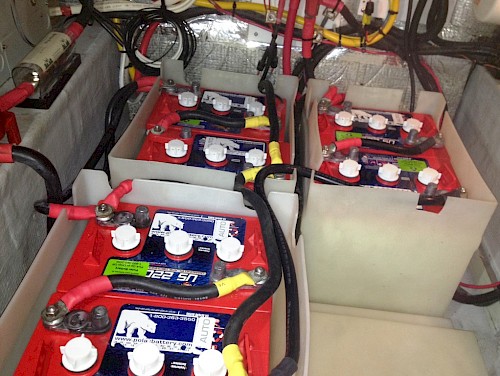
Battery Bank Capacity Calculation
Batteries are available in many voltages, types, and sizes. It is common to cable batteries together to make a bank of batteries of a different voltage or amperage capacity.
Lead/acid batteries are most commonly available as 6V or 12V varieties, but, you can find and pay a premium price for, 2V, 8V, or 24V batteries. Batteries in all those voltages are available in different capacities, and generally the size and weight of battery will increase as the capacity increases.
Although boats can have many different voltages, for comprehensive electrical services, it is most common for cruising boats’ DC devices to operate on a single voltage, usually 12VDC. It is also common for battery capacity to be determined and given as either at 20hr rate, or reserve minutes capacity. For storage batteries the 20hr rate is the most often seen and used for calculating capacity.
For example, if you have a 12VDC system you can purchase two 12V batteries with 100Ah @ 20hr rate. By wiring them in parallel, positive post to positive post and negative post to negative post, you will get a 12VDC bank with a 200Ah @ 20hr rate battery bank. However, if you have two 6VDC with 100Ah @ 20hr rating and you want to use them for a 12VDC system, then they will be wired in series, positive to negative post, and you will get a 12VDC bank with 100Ah @ 20hr rate.
A very common battery bank setup is four 6V batteries with a 125 Ah rating @ 20hr rate. This bank will comprise of two series cabled pairs of batteries paralleled together to make a 12VDC bank with a 250Ah capacity @ 20hr rate.
- Lyle
PYS Electrical Technician
Related Content












 $258.00
$258.00 $181.22
$181.22



















